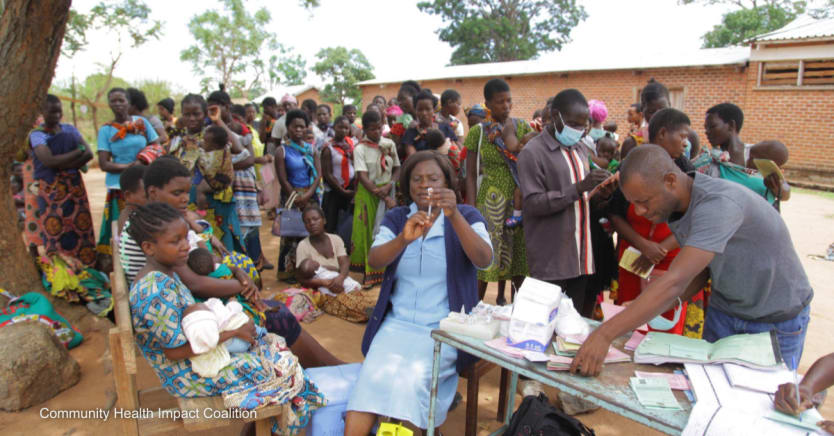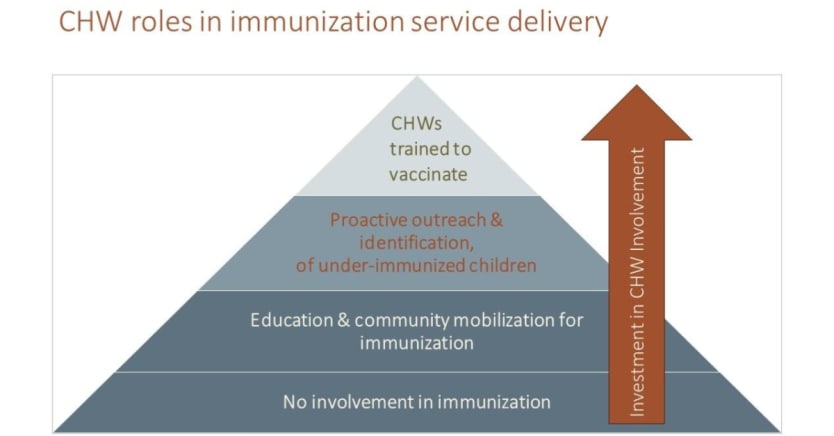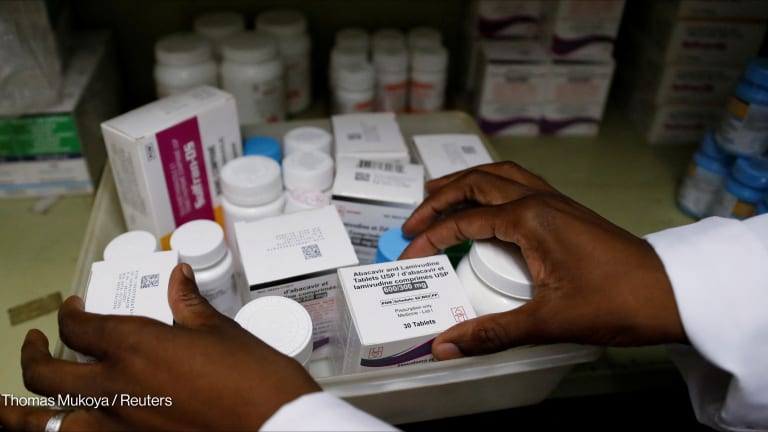This opinion article has been co-authored by Rebecca Alban, senior manager of Health Systems, VillageReach; Chifuniro Chiyendausiku, disease control surveillance assistant in Malawi; Michele Gaudrault, technical director, health and nutrition, World Vision International; and Tessa Oraro-Lawrence, director of advocacy, Community Health Impact Coalition.

Vaccines are a cornerstone of successful public health interventions. Yet, despite their effectiveness, 67 million children worldwide still lack access to basic vaccinations. This gap underscores an urgent need for strong immunization programs to reach Immunization Agenda 2030, or IA2030, goals.
Central to strong immunization programs are community health workers, or CHWs, — the frontline workers who bring health services straight to their neighbors’ doorsteps and often act as the only touch point to the health system among the hardest-to-reach communities. CHWs carry out complex health tasks and health promotion activities. They play a profound role because they both live in and are trusted by their communities. And they’re cost-effective.
As CHWs, and the organizations that support them, we believe the evidence is clear: CHWs are critical to achieving IA2030 goals. With an estimated 10 million shortfall of health workers by 2030, we know CHWs can increase coverage and equitable access to routine immunization by addressing vaccine hesitancy, identifying zero-dose and under-immunized children, and supporting emergency response during vaccine-preventable disease outbreaks.
Challenges hindering CHW effectiveness
CHWs hold immense potential to increase global immunization efforts. However, several challenges currently hinder their effectiveness. First, many countries lack an enabling policy environment that allows for and provides clarity around increased CHW involvement in vaccination programs.
Second, CHWs are often not recognized as professionals. They are unpaid and/or underpaid and lack access to immunization training on how to track child vaccine status, administer vaccines, and manage vaccine commodities. They also lack the required levels of supervision needed for such responsibilities.
Third, research indicates that CHWs are excluded from national supply chain planning in most countries and are stocked out of essential medicines nearly one-third of the time. Last-mile immunization supply chains often face several challenges related to delivering and safely storing supplies. Addressing these immunization supply chain issues is critical, given that most CHWs are delivering services to these communities.
Fourth, CHWs are often tasked with heavy workloads. In Malawi, for example, they travel up to 14 km on bicycles during vaccination campaigns and have very hectic schedules that require them to vaccinate up to 500 children a week. All too often we see CHWs being left out of important national vaccine campaign planning and decision-making that affects their ability to do their jobs.
Lastly, many countries do not accurately track CHWs or clearly define the types of services they should and can provide. For example, some countries work with CHWs for health promotion and education only, while in other countries such as Malawi, CHWs are a paid workforce and have been involved in vaccination for decades. This lack of global clarity and guidance hinders CHWs’ expanded involvement in immunization.
This week, members of the world’s highest health-policy body are meeting for the World Health Assembly in Geneva, Switzerland. Join us at the following events to prioritize investments that can expand access to life-saving vaccines by unlocking the full potential of Community Health Workers.
Reaching the Unreached: Achieving Immunization Equity through Community Health Worker Investment
Wednesday, May 29 at 8:00 - 9:30 a.m. CET
Location: Grand Salon at Impact Hub Geneva
Register here.
Reaching the Most Vulnerable Contexts with Immunization
Sponsored by World Vision International, IRC, and VillageReach
Thursday, May 30 from 3:00-6:00 p.m.
Location: Global Health Campus
Register here.
Investing in CHWs for better vaccination coverage
Lessons learned from COVID-19 vaccination efforts and increasing evidence highlight CHW involvement as a key enabling factor in expanding routine immunization. CHWs can participate in various ways, but to achieve global goals, we need to move their involvement up the “pyramid” to expand their role in immunization service delivery.

The top three tiers in the figure above represent increasing levels of CHW involvement: From supporting immunization programs by carrying out education and promotion, using tools to track and identify zero-dose and under-immunized children, to administering vaccines, both oral and injected. To facilitate CHWs moving up this pyramid we need collaboration. Donors, global health institutions, and implementing partners must work with governments and listen to the voices of CHWs to address current challenges and act on the recommendations below.
● Global Guidelines: Develop global guidelines outlining CHW involvement in vaccination programs, drawing from available resources and tools for optimizing community health programs such as the World Health Organization guideline, Community Health Worker Assessment and Improvement Matrix, and the Health Systems Assessment and Improvement Matrix.
● National frameworks: Advocate governments to develop policies allowing for CHW involvement in immunization, up to and including as vaccinators.
● CHW participation: Include CHWs and organizations that support them in related governance structures and decision-making bodies for national and subnational immunization delivery.
● Standardized training: Organizations that set standards in CHW training, such as WHO and the Africa Centres for Disease Control and Prevention, should guide the development of standardized CHW training curricula specific to immunization.
● Professional CHWs: Recognize CHWs as professionals and set them up to succeed with the salaries, skills, supervision, and supplies they require. For immunization services to be equitable, sustainable, and resilient — even at the last mile — CHWs and their supervisors must be representative of and recruited from the communities they serve.
● Human resources for health: Countries need to adequately and consistently train CHWs for their roles. This includes education on how to track immunized children in their communities, manage cold chain distribution and storage, and administer vaccines, where allowed.
● Data-driven strategies: Establish national, up-to-date, georeferenced CHW registries that not only count the national CHW workforce, but also enable effective training, deployment, payment, supply, and supervision of CHWs.
● Strengthened supply chains: Programs should strengthen community supply chains to ensure CHWs have materials and commodities, reliable and safe transport, adequate vaccine storage, and digital tools for data visibility. These should be integrated into national immunization supply chain planning.
Reaching every child, building a healthier future
To reach all children with vaccines we must unlock the full potential of CHWs. This requires including CHWs in global strategies such as IA2030 and Gavi 6.0, increasing funding for CHW immunization programs, and expanding the evidence base to quantify the best ways to leverage CHWs for immunization programs.
Millions of CHWs globally dedicate themselves to improving the health of their communities. By investing in them, we will not only achieve higher immunization coverage but also build a more resilient, equitable, and responsive health care system for all. Investing in CHWs is investing in a healthier future for every child.








